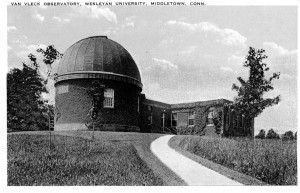Dedicated June 16, 1916, Van Vleck Observatory celebrates its centennial this year. For one-hundred years the observatory has inspired young astronomers and others in the Wesleyan community.
In 1960, John Cage came to Wesleyan as a visiting professor in the Center for Advanced Studies. While exploring Wesleyan’s campus, Cage discovered the observatory’s Van Vleck Library. Bill Jefferys (Emeritus Professor of Astronomy, UT-Austin) was a junior at Wesleyan, working at the observatory, when Cage visited, searching for star charts to guide his music, a new experiment in composition. Bill presented Cage with Antonín Bečvář’s Atlas Eclipticalis, one of few astronomy books printed entirely in color at the time. The book inspired “Atlas Eclipticalis,” a composition that relies on the placement of stars within constellations, rather than the orthodox implementation of musical notes. Using a transparent music staff, Cage composed this piece, basing each note’s sound upon the size and color of the stars which landed on the staff. Greater detail of the piece’s creation can be found in the series of Selected Letters of John Cage edited by Laura Kuhn.
“Atlas Eclipticalis” has become an iconic piece of music, raising questions of improvisation and musical ownership. The piece will be formed today, May 1, as part of a concert in celebration of the Van Vleck Oberservatory’s 100th anniversary.
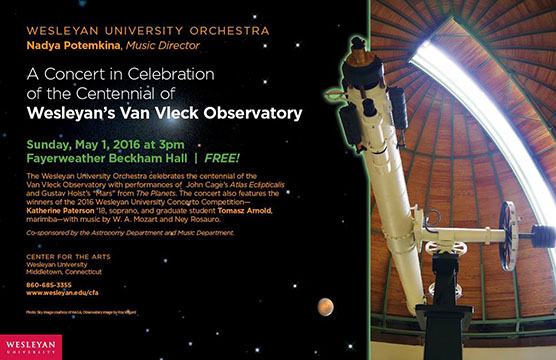
In his own words, here is Bill Jefferys’ story of his encounters with John Cage:
I was aware that John Cage was at Wesleyan, in the Honors College, that year. I would have been a junior in 1960–61, and I had some duties in the Van Vleck library, probably making sure that books left around got back to the right place on the shelf…I was the only astronomy major during my years at Wesleyan (1958–62). I happened to be in the library when John Cage wandered in, looking for star charts to use in his music. His idea was that you could put a transparent music staff randomly on the chart, which would make potential notes become real notes, indicated by where the stars happened to be at that point. I was aware that Bečvar’s Atlas Eclipticalis had just been printed…we had recently received a copy. Unlike most star charts of the time, this book was in full color…stars had their colors indicated by the color in the chart and of course the size of the image indicated the magnitude. Also, nebulae were indicated in green. I showed this to Cage, whose eyes lit up as I think it was a lot more than he expected. I helped him check it out, and he took it down to the Honors College to work in his piece.
A year or two later, I forget which, I learned from the late David McAllester, who had been one of my favorite professors at Wesleyan, if not the favorite, that the US premier of Atlas Eclipticalis was to be presented at what was then Connecticut College for Women (now just Connecticut College, I believe). David invited me to go along with him and his wife Susan to attend this event, which I did. Susan brought along a very large shelf fungus that she had collected at their place in the Berkshires (Monterey, MA), and presented it to Cage prior to the performance. Cage was delighted as he was a very good amateur mycologist. The performance was the music for a dance performance by Merce Cunningham, Cage’s longtime companion and lover, and his troupe. Cunningham was dressed as a chicken, I believe. The whole affair was quite amusing.
Cage had a custom of dedicating parts of his compositions to friends and colleagues; There was a part dedicated to David and Susan McAllester, for example, and also to the chair of the music department at the time, whose name escapes me. Some years later I wrote to Cage and reminded him about how he came by the Atlas Eclipticalis. In return he wrote me a letter (which is somewhere in the attic) in which he dedicated the Second Bassoon part to me. This may well have been one of Cage’s jokes, as there may not actually be a Second Bassoon part! I don’t know, but I’ve always been amused by the notion.
My favorite mycology story about Cage is from Silence: He had taken a course on mushroom identification at the New School, and the professor took the class out for a field trip. One of the students brought a mushroom to him, which the professor identified as such-and-such a species (I forget the name, but it is in the book and on the recording). The professor declared it “edible.” Cage, however, thought it was a different, and possibly poisonous species. Cage reports that this put him in a dilemma: Should he keep silent, and perhaps be responsible for a student poisoning himself, or should he speak up? He spoke up, and the professor said, well, let’s key it off. Which they did, and it turned out that Cage was right. After the field trip, the professor took Cage aside and asked him, how come, since he seemed to know so much about mushrooms, he was taking the course? Cage responded that there was a lot that he didn’t know. Cage then asked the professor why he had made a mistake in identifying that mushroom. The professor responded, “My specialty is the jelly fungi; I just give the fleshy fungi a whirl.”
So, that summarizes what I know about the origins of Atlas Eclipticalis and the relation to Cage’s Wesleyan visit.
New from Wesleyan:
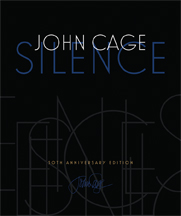 |
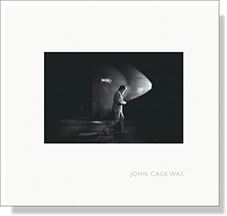 |
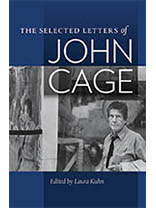 |
Also available:
MUSICAGE: Cage Muses on Words

